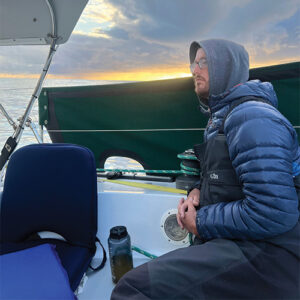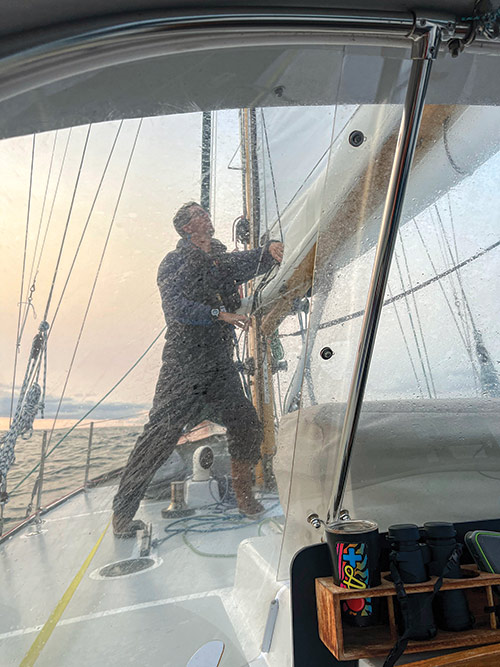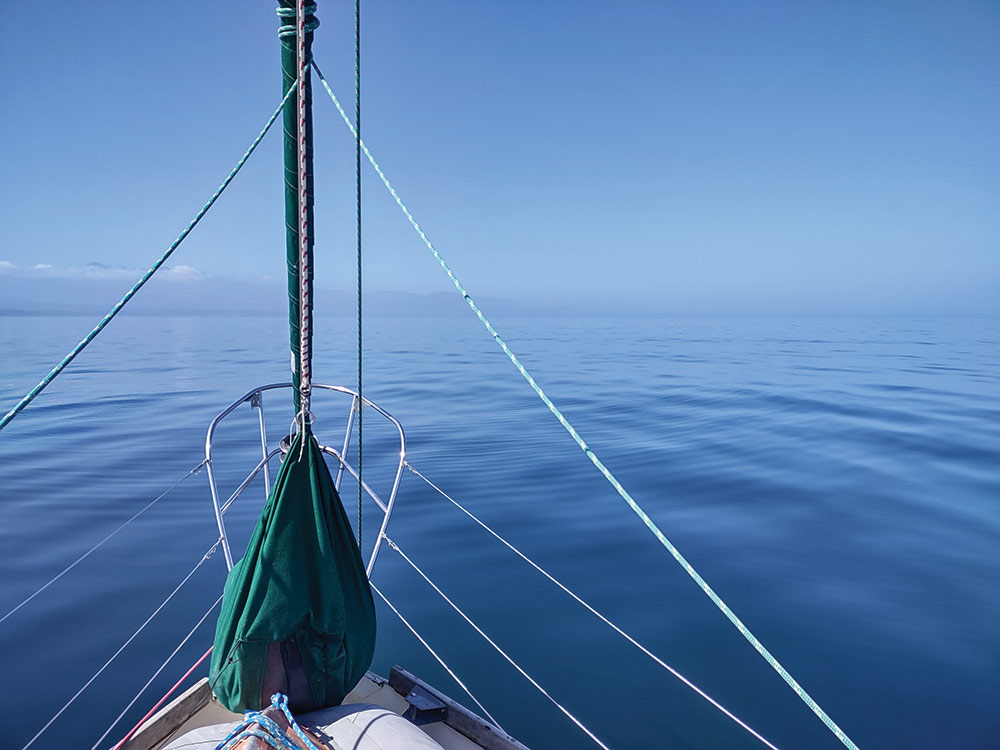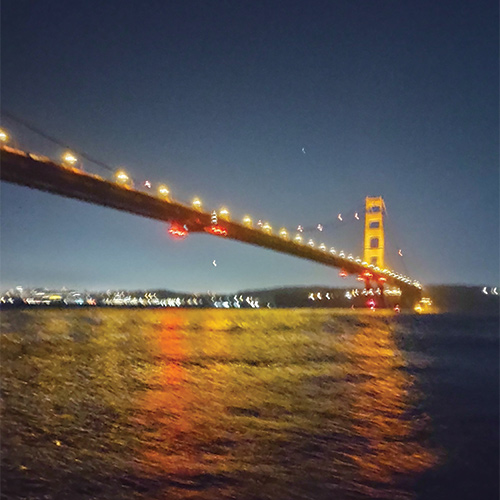
With years of dreaming, planning, and boat work in our wake — and after days of moving out of our apartment, loading the boat up with all our belongings and gear, and meeting with our crew — we took off from our home for the past several years, Port Townsend.
Riding the end of the outgoing tide on August 17, my wife Lizzie and I, along with our crew Molly and Cameron, motored past Point Wilson and waved goodbye from our Kendall 32 sailboat, Shaula. I’ve had Shaula for the past nine years and we’ve spent the last few working endlessly to get this “project boat” ready for a life of cruising. Glass calm waters met us in the Strait of Juan de Fuca as we set a westward heading and began our journey towards the Pacific Ocean.
Motoring slowly along, we contemplated what was to come. We were definitely elated to be free of our jobs and heading out for a big adventure. Still, leaving Port Townsend was a little sad. It had been a great place to start out our marriage and we will miss our good friends back there. As we started disconnecting from shore life over the last few months and had a wonderful going-away party in mid July, Port Townsend endeared itself to us further as we showed friends and family all that we had shared there. Beginning a journey like this, though, we felt curious if we’d ever see it again.
For the first day of the trip, we decided to just get out of town and anchor in nearby Sequim — gale warnings in the strait for the night reinforced this call. The channel here winds along through a few S-turns as it makes its way into the bay behind, and we found a great spot to anchor just south of the marina. Now that we were all aboard, we used the time to get accustomed to the boat, run through some safety talks, and discuss the voyage plan as a crew. We enjoyed enchiladas for dinner and headed to bed early.

The Strait of Juan de Fuca runs west from Port Townsend to Cape Flattery and the Pacific beyond, just under one hundred miles long. Shaula only travels at about 5 knots under power, so it would be a few days before we even reached the ocean. Day two had us once again motoring toward our next stop, Port Angeles. It was a pretty uneventful day. We hadn’t finished setting-up the autopilot for the trip, so our time steering the boat involved standing with one hip against the tiller pushing it slightly to port. Over time, this left a nice sore spot on our legs, so we learned to find new ways to hold the tiller in place — turns out a $5 piece of line worked great.
We had a mission in Port Angeles to complete our provisioning for the trip. We needed enough food, water, and other supplies for a possible two-week trip down the coast. Our other Port Angeles project was to set up our Monitor windvane steering, which steers the boat without the use of electricity. With those items off the checklist, we headed out for our last slices of pizza and sips of beer before heading down the desolate Northwest coast.
We set off an hour before dawn on day three with the steaming light shining brightly aloft. The motor pushed us through the flat-calm waters and the electric autopilot was now driving us westward, so we could sit down and relax. We had about 55 miles to cover and wanted to be into Neah Bay before 5 p.m. Everything went smoothly and we enjoyed snacks and the sunshine.
It was interesting to watch the coastline as we slowly motored past. It never really seems to go by at all and, as we looked at the charts, the miles seemed never ending; but the land is constantly changing, with some areas that have been heavily logged and other parts of the coast line revealing its wild roots with stretches that look like they’ve never been touched. The salmon were running as we passed through the central portion of the strait, and watching them fling themselves out of the water provided additional entertainment.
As we kept puttering on, the swell from the ocean started to show up, even though we were 50 miles away. There were big winds blowing out there and we could feel the effects. Shaula started rolling up and over the waves, and then my stomach started rolling up and over itself too. This began my long hideout down below in the V-berth. Luckily, we pulled into Neah Bay a few hours earlier than expected and, dropping anchor near the breakwater, we got to enjoy calm water once again.
We stayed put the following day because the weather out on the Pacific was still pretty unsettled. Waiting another day would let the winds ease and the waves flatten out from about 10-15 feet to 8 feet. It was forecast to keep getting calmer as we headed south. We took this free day to work on various boat projects, rest up, and download all the music we hoped would keep us occupied for the next week or so. Later that afternoon, we dropped the dinghy in the water and rowed over to shore to check out the small village. This is Makah tribal land, and the village is about ten blocks long with a gas station and a few small cafes, along with a great general store with everything from fried chicken to metric stainless fasteners. On our walk, we found the Makah Museum, which shared the history of the indigenous people who called this area home, and told about the giant landslide that covered their homes, sort of a local Pompeii.
That night, we stowed the dinghy back aboard and ran through all the safety gear. We made straps to hold cabinet doors shut and double checked the engine, rigging, and sails. The next day, it was time to meet the North Pacific.

Monday, August 21 was our first day on the ocean, and once again we had a pre-dawn departure. It was only a few miles out to Cape Flattery and Tatoosh Island and we set out due west to try and break free of the coastline as much as possible before heading south. While the winds had died down, the swell was still there and we quickly started bucking around in it. Our goal was to get out roughly 60 miles offshore and past the shipping traffic that moves up and down the coast. We hoped getting into deeper water would also mean more consistent waves. The ebb current coming out of the strait made the waves even more rowdy, so we opted to start working southwest in an attempt to get out of the strongest current.
The weather was beautiful as we motored along in light winds. Our crew was settling into the boat and we enjoyed a quiet first day, other than the motor and the rock tumbler noise the back of the boat makes. We had sorted out a watch system that would give us each a solo watch for three hours, and later in the day another three hour watch with another person.
The wildest moment of the first day came as I was off-watch and hanging down below in the V-berth. With room to spread out and a nice mattress, it is the most comfortable place in the boat by far. Lizzie, Cameron, and Molly were on deck when they saw a little airplane or something in the distance. All of a sudden came a deafening roar as a fighter jet flew over the boat by only a hundred feet or so. This made me fly to the hatch to see what it was but it had zipped right by and back to wherever it had come from. It would probably take them 10 minutes to get home, versus our three days to get to this point… we need a faster boat.
We finally started sailing a little on Tuesday morning off Grays Harbor. We couldn’t see land, but our chartplotter showed the slow path we were making southward. Clouds started popping up in lines to the west, some with rain. This brought back memories of Caribbean rain squalls, and this is exactly what they did to us. We were sailing along in perfect breezes when I suggested we furl up the headsail. Not 10 seconds after we did that, the squall hit us with pouring rain and wind in the mid 20s. We held on as we bounced around in the confused waters. After the clouds passed, we tried to sail again, but this time with no wind and waves twice as large.
Tuesday was probably the longest day for all of us. The boat just didn’t seem to go anywhere. We motored in various directions, but the bow would raise up in a wave then crash down, bringing the stern and the propeller out of the water. Shaula would stop and rock around until a calm spot allowed us to get a little speed, and the whole process repeated itself. All day long… We tried everything to get the boat rolling south again. On top of that, my belly was over it, and I went down to lay on my back, which is the best way for me to get rid of seasickness. I did this for the next few days.
Sometime during this wave rodeo, Lizzie made a quiche. She was the true hero of this passage. Standing extra watches, cooking incredible meals, and directing the crew what to do. She was amazing.
Wednesday brought calmer weather, so calm we had to continue motoring in light winds south of the Columbia River. With my seasickness, I’d get up and check in with the crew and head right back to bed. The ocean was putting me through the ringer. At one point, laid out comfortably on the port side settee, a wave broke on the side of the boat and water came down through the deck hatch right on top of me. The only reaction I could muster was to switch pillows, strip off my soaked sweatshirt, and lie back down on the wet cushion.
Whenever my watch would come up, I would try to convince the crew that we should head to shore and get more fuel. It was probably just a delirious scheme to get to a dock and be somewhere comfortable, but Lizzie would quickly bring me back to reality. We were 85 miles offshore. It would take a full day just to get to shore. With weather possibly brewing farther south, we needed to hurry along. If I had succeeded in any of my several attempts to head to shore, we’d be stuck somewhere waiting for another weather window.
We had a quiet day on Thursday. My seasickness continued — usually it would have worn off by then, but the choppy waves persisted into our trip a little longer. Having two crew with us was plenty of coverage for watches and boat handling, and I stayed hunkered down in the V-berth. I heard a few rumblings from the back of the boat as the engine turned on or off with the changes in wind, and in celebration as another incredible feast came out from our humble galley with limited space and a stove that isn’t gimballed.

By Friday, still motoring in light wind, I was really looking hard at the amount of fuel we had left and the distance still to cover. We were in northern California and keeping an eye on a growing weather system that was generating northerly winds south of Cape Mendocino. We were hoping to get closer to this and catch some nice winds to carry us into San Francisco Bay. The winds seemed to be staying just ahead of us. Little zephyrs would float through and we’d try to sail but half-a-knot of boat speed wasn’t going to get us anywhere.
Giving up on sailing for now, Lizzie decided to have a foredeck party, with charcuterie and all. What a treat! Cam, Molly, and Lizzie enjoyed the sun and flat seas on the foredeck while I stood watch in the cockpit. Soon, we noticed a whale out in the distance. It was slowly moving around the surface and did a full circle around the boat. A humpback, and by the width of its back, it was the biggest we’d ever seen.
Near the end of the daylight hours, Molly demanded we go for a swim. We dropped the mainsail, brought the engine to a stop, and as the boat crawled to nothing, Cameron and Molly jumped off the side. It was wild to be so far offshore with not a hint of wind and seas so flat the horizon went on forever. With 3,000 feet of water below us, the blueness of the ocean was astounding. Sunset quickly brought an end to our dip, and we fired the boat back up and continued on into the night.

Getting farther into California waters on Saturday, we noticed an abundance of sea life. More whales were showing up, and we had an amazing number of dolphins visit the boat. At one point, we probably had 50 near the boat with groups of 10 to 20 playing under the bow waves.
When we finally got enough wind to sail, it was perfectly downwind; a great opportunity to try the spinnaker out. We never would have guessed that 10 hours later, we would still have it up without ever touching the sheet to trim the sail. That’s the great thing about ocean sailing, not having to tack or jibe constantly and being able to set the boat up to manage itself for long periods of time.
We were right in line with Cape Mendocino as night fell. This area can create some nasty storms and big seas. On my last trip through here in 2009 with my friend David Kilmer on his 36-foot sailboat, we came near the point the wind kept increasing and finally topped out around 50 knots with 20 foot seas. As the moon rose in the east, I was so thankful that we were in calmer conditions this time around.
I came on deck overnight to see how Lizzie was doing, to find the sky perfectly clear and so full of stars. When I came out of my cave shortly before sunrise, we were buried in fog and in a building breeze with too much sail up. Getting dressed down below and switching between holding on and trying to pull on bibs, boots, and most importantly, lifejackets, was a battle. I came on deck to help Molly reef sails and get Shaula sailing at a slightly calmer rate. Our little boat gets powered up pretty quickly — in 16 knots of wind, we had a double-reefed main and half of the jib rolled out. Depowered for safety and solo boat handling for the person on watch, we were absolutely flying downwind with only a day’s sail left to San Francisco.
Soon, the fog thickened and we were down to maybe a hundred yards of visibility. With the navigation lights on during the day, the radar spinning around, and two of us in the cockpit keeping lookouts, we felt pretty safe. We were nearing Point Arena and it looked like we would arrive in the bay late that evening.
As the day wore on, the fog eventually burned off, bringing breeze and waves. The jib was rolled up and the mainsail stayed double reefed as Shaula surfed down the waves at over 9 knots! The waves increased to about 12 feet, and the boat got back to its rolly nature when sailing dead downwind. Rail to rail the boat would go, and luckily we’d figured out how to keep everything and ourselves secured from flying around. After several days of feeling like I was past the seasickness, this once again sent me to the V-berth for more Saltine crackers and Sudoku. I occasionally glanced aft out of the hatch to see large waves cresting and rolling into foam behind the boat. Cameron, Molly, and Lizzie were champs throughout the day, handling the boat safely and we rounded Point Reyes just before sunset.
This was when I was alerted to something in the cockpit with a loud yell of “holy crap!” There was a large group of humpback whales leaping out of the water. Maybe they were corralling fish or just having fun, but it was absolutely incredible to see so many of them in one place. I’m sure this will be a lasting memory, the huge group of whales paired with our first glimpse of land in the background after a week at sea, the almost full moon was starting to come up over San Francisco and the sun was setting into a cloudless western horizon.
In front of us lay the lights of the Golden Gate Bridge and our final obstacles of the trip. Shipping lanes converge into one inbound and outbound lane, and watching for the lights of big ships got increasingly difficult against the backdrop of city lights. The other obstacle was the building ebb tide. We were already battling almost 2 knots of current by the time we got to the bridge. An hour or two later, and we might have been stuck spinning circles in the ocean for the rest of the night waiting for the tide to change.

Lizzie was at the helm as we approached the Golden Gate Bridge shortly before midnight. We all gathered on deck to gaze upwards as our little navigation lights passed under the many orange and red lights of the gigantic bridge above us. We had made it!
Well almost. It took all of our faculties to reach our slip at Schoonmaker Point Marina in Sausalito, fighting current, fatigue, and complex navigation. We tied Shaula up and turned off the engine just before 1 a.m.
Tah-dah! We completed our voyage south in 6 days and 19 hours, which is pretty quick for a little 32-foot boat. It was very rewarding to have made this first passage on what had started as my “project boat.” We were finally out doing what we’d been dreaming of. But at that moment, we were too tired to celebrate. It was bedtime.
I am so grateful to Molly and Cameron for spending a week offshore with Lizzie and me, taking the time off from school, partners, boats, and life to spend 10 days on Shaula. I’d sail any ocean or latitude, and on any boat with them; and I hope I get to do so.
Lizzie was simply incredible during this trip. It was tough to be locked down and sick during so much of the trip, and she was the absolute best captain. She navigated the boat south when I wanted to go east. Her provision planning and ingenuity in the galley created amazing meals onboard in very unamazing conditions. I can’t wait for the next legs of the voyage with her. Stay tuned for more of our adventures aboard Shaula!
After years of living in the Pacific Northwest and working in the marine industry, Scott and Lizzie have set off for a multi-year cruise aboard their Kendall 32, Shaula.






